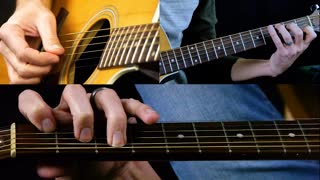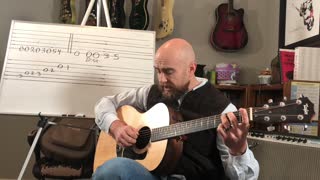Relative Scales Guitar Lesson [How to Solo Major Minor Scales]
This relative scales guitar lesson will show how to solo with major and minor scales.
Guitar Scales Lesson Playlist
https://www.youtube.com/watch?v=fy0YgszScUI&list=PLOKVJibwUTbrYl16LJ2F7_I9_TvbvzLl8
Relative Scales Guitar Lesson [How to Solo with Major and Minor Scales]
0:00 Lesson Preview
0:26 Guitar Scales Basics Foundation
0:58 Relative Scales - 3 Frets Apart
1:52 Relative Scales - Connected Patterns
2:27 How to Harmonize Relative Scales
4:58 Backing Rhythm Track in A Minor
5:48 'Taking the Edge Off' Pure Scale Moods
6:50 More Relative Scale Combinations
7:42 Backing Rhythm Track in B Minor
8:32 Relative Scales - Different Keys
9:47 Backing Rhythm Track in B Minor
How to Play and Solo with the Minor Scale on Guitar
The standard (Natural) Minor scale box pattern for guitar covers a span of only three frets. In order to
play the Minor scale on guitar along other fret positions, other box patterns need to be played along with new soloing
techniques.
How to Play and Solo with the Major Scale on Guitar
The standard Major scale box pattern for guitar covers a span of only two frets. In order to
play the Major scale on guitar along other fret positions, other box patterns need to be played along with new soloing
techniques.
Relative Scales Guitar Lesson
The first step is to know how relative scales work on guitar, which is being able to harmonize relative
major and minor scales together without sounding out of key when learning to solo on guitar. This relative scales guitar lesson will show how to solo with the major and minor scales on guitar.
Relative Scales on Guitar
On guitar, the relative major scale box pattern will always be located three frets higher from the minor
scale box pattern. For example, the relative major scale to ‘A’ Minor (5th fret position)
would be ‘C’ Major (8th fret position - three frets higher). For this initial guitar lesson on relative scales, this general explanation
will suffice as other lessons will go into more detail on how to harmonize relative scales on guitar.
Connected Guitar Scale Box Patterns
The ‘A’ Minor and ‘C’ Major scale box patterns on guitar actually ‘fit’ together, with the bottom of the ‘A’ Minor
box pattern being identical to the top of the ‘C’ Major scale box pattern along the eighth fret position.
These two guitar scale box patterns combine to form one larger connected box pattern that covers a
span of five frets. This connected box pattern on guitar can be played in any key.
How to Solo with Relative Scales on Guitar
The first step with harmonizing relative scales on guitar is to simply shift or alternate between major and minor scale
riffs within the connected box pattern. Before soloing and harmonizing relative scales on guitar with a backing rhythm track, review playing major and minor scale guitar riffs from
previous lessons. Focus on alternating between the major and minor guitar riffs from each box pattern.
The primary objective with this first guitar lesson on relative scales is to simply hear how Major scale riffs will harmonize with relative Minor scale riffs. The reason why these relative scales
harmonize together in a guitar solo is that both the ‘A’ Minor and ‘C’ Major scales share the same seven notes (‘A’,
‘B’, ‘C’, ‘D’, ‘E’, ‘F’, & ‘G’). Though there are more specific details to learn later about phrasing with
relative scales, simply hearing how relative scales harmonize on guitar is a major step in
understanding more about improvisation, because what was once initially understood as a 'pure' ‘C’ Major
scale riff can now be also be viewed as a relative major scale riff that harmonizes with the ‘A’ Minor scale.
Relative Keys on Guitar
The same concept that applies to relative scales on guitar will also apply to relative keys on guitar.
All of the ‘A’ Minor and ‘C’ Major riffs that harmonize with the chords in
the Key of ‘A’ Minor will also harmonize with chords from the Key of ‘C’ Major.
Paluzzi Guitar
The objective of the Paluzzi Guitar video series is to help establish a foundation of guitar fundamentals by applying various playing techniques (rhythm, fingerstyle, and soloing) to various styles of music. The more playing styles and techniques a guitarist can learn, the more diverse and self-sufficient a guitarist will become. A self-sufficient guitarist can then teach themselves, communicate with other musicians, and even write their own music once a solid foundation of fundamentals is established.
The Creative Guitarist Method Series was written and designed by Kevin J. Paluzzi of Paluzzi Guitar Instruction in San Diego, CA. For more information on private lessons and books, go to:
San Diego Guitar Lessons
http://www.PaluzziGuitar.com
Relative Scales Guitar Lesson [How to Solo with Major and Minor Scales]
-
![How to Harmonize Minor Scales Guitar Lesson [Blues Flamenco Riffs]](https://hugh.cdn.rumble.cloud/s/s8/1/l/-/1/H/l-1Hb.0kob.3-small-How-to-Harmonize-Minor-Scal.jpg) 13:43
13:43
PaluzziGuitar
3 years agoHow to Harmonize Minor Scales Guitar Lesson [Blues Flamenco Riffs]
164 -
 6:26
6:26
Groove And Company
3 years agoLesson 2 Minor Scales and Relative Minors
25 -
 1:51
1:51
BeatleLessons
2 years agoPink Houses Guitar Lesson
63 -
 5:38
5:38
Center Stage Guitar Academy
3 years ago $0.01 earnedGuitar Lesson 3 - How To Play C Major Chord
179 -
 7:53
7:53
GuitarTeacherRob
3 years ago $0.01 earnedFirst Guitar Lesson: Part 3, Songs, & Scales
64 -
 18:02
18:02
Speedracer100
2 years agoFirst Time Guitar Lesson
59 -
 8:11
8:11
Vigilant News Network
8 hours agoCOVID “Vaccines” Hit By New Bombshell | Beyond the Headlines
38.3K30 -
 1:00:39
1:00:39
In The Litter Box w/ Jewels & Catturd
22 hours agoBiden is a Confused Embarrassment | In the Litter Box w/ Jewels & Catturd - Ep. 583 - 6/10/2024
66.9K42 -
 2:02:23
2:02:23
Revenge of the Cis
5 hours agoEpisode 1355: The Hero We Need
40.5K17 -
 1:57:02
1:57:02
Film Threat
10 hours agoVERSUS: THE ACOLYTE DESTROYS STAR WARS | Film Threat Versus
52.4K1